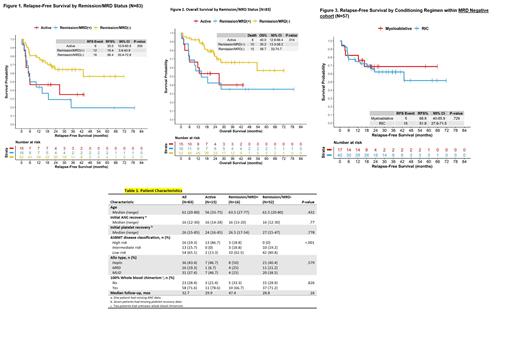Abstract
Introduction
Allogenic hematopoietic cell transplant (HCT) for acute myeloid leukemia (AML) is a curative option in patients with intermediate/high risk disease who achieve morphologic complete remission (CR) after induction chemotherapy. Patients in CR but with positive measurable residual disease (pMRD) prior to HCT had high relapse risk(RR) (67% vs 65%) and low 3 year overall survival (OS) (26% vs 23%),similar to those with active disease in a single institution study (Araki et.al; Volume 34, Feb 1,2016, JCO). However, this study included only patients who received myeloablative conditioning (MAC) and included both peripheral blood and marrow grafts. A single institution retrospective study showed that use of MAC compared to reduced intensity conditioning (RIC) improved 3 year RR(19% v 67%; P < .001) and OS( 61% v 43%; P = .02) in patients with pMRD/CR(determined by molecular analysis of limited gene mutational panel)(Hourigan et.al. Volume 38, April 20,2020, JCO). We analyzed a cohort of AML patients that underwent either MAC or RIC followed by peripheral blood stem cell grafts and post-transplant cyclophosphamide (PTCy) based GVHD prevention regimen at our institution to determine the effect of pMRD on transplant outcomes.
Methods:
To evaluate the impact of pMRD on transplant outcomes, we analyzed AML patients who underwent HCT at Levine Cancer Institute between June 2014 and April 2020 with MRD testing performed within 1 month prior to HCT. MRD testing was performed at University of Washington by using multiparametric flow cytometry (MPC). The overall sensitivity of the assay is conservatively estimated as 0.1%. In our institution, all patients received MAC (Bu/Flu) or RIC (Bu/Flu or Flu/Cy/TBI) regimens followed by peripheral blood stem cell grafts and identical PTCy-based GVHD prophylaxis regimens that included tacrolimus and mycophenolate. Patient and transplant related characteristics were presented via descriptive statistics. Corresponding P-values were determined using Fisher's exact test for categorical variables and nonparametric Mann-Whitney U test for continuous variables. Relapse-free survival (RFS) and OS were estimated using the Kaplan Meier method. All statistical tests were two sided, and a P-value < 0.05 was considered statistically significant.
Results
From June 2014 to April 2020, 105 patients with AML underwent HCT. Eighty-three patients with MRD results were included in the final analysis - 52 (63%) with negative MRD (nMRD)/CR, 16 (19%) with pMRD/ CR and 15 (18%) with active disease (no CR). Baseline characteristics were similar except for presence of significantly greater number of high risk patients, based on ASTCT disease classification in the active disease group compared to pMRD/CR and nMRD/CR cohorts( 87% vs 19% vs 0%, P =< 0.001). Median follow up for the entire cohort was 32.7 months. RFS was superior in patients with nMRD/ CR compared to pMRD/ CR or active disease (56.4% vs 19.4% vs 35%, P= 0.005). In addition, OS was superior in nMRD/ CR compared to pMRD/CR or active disease (56.7% vs 35.2% vs 40%, P= 0.014). The use of MAC compared to RIC did not improve RFS (0% vs 32%, P= 0.018) and OS (0% vs 44%, P= 0.071) in pMRD/CR cohort. The use of MAC or RIC did not significantly impact RFS (69% vs 52%, P=0.729) or OS (61% vs 53%, P=0.739) in nMRD/CR patients.
Conclusion:
Our study validates the previous data that prognosis of patients with pMRD/CR (determined by MPC) prior to HCT is not significantly better than those having active disease. The outcomes were poor regardless of conditioning regimen intensity and PTCy based GVHD prophylaxis used at our institution. These patients might benefit from additional chemotherapy or targeted treatments to achieve nMRD prior to HCT and/or maintenance therapy post HCT. Patients with nMRD/CR disease had similar outcomes with MAC or RIC. This finding suggests that less aggressive conditioning regimens incorporating PTCy could be considered in a subset of patients with nMRD/CR, thereby sparing them from complications associated with MAC. Prospective trials are needed to further study these findings.
Copelan: Amgen: Consultancy. Grunwald: Astellas: Consultancy; Karius: Consultancy; PER: Other; Gilead: Consultancy; Incyte: Consultancy, Research Funding; Amgen: Consultancy; PRIME: Other; Daiichi Sankyo: Consultancy; Bristol Myers Squibb: Consultancy; AbbVie: Consultancy; Trovagene: Consultancy; Stemline: Consultancy; Pfizer: Consultancy; Janssen: Research Funding; Blueprint Medicines: Consultancy; Sierra Oncology: Consultancy; Med Learning Group: Other; Cardinal Health: Consultancy; MDEdge: Other; Agios: Consultancy.


